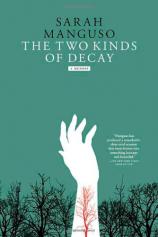Reading Group Guide
Discussion Questions
The Two Kinds of Decay

1. In her closing lines, the author writes, “There are two kinds of decay: mine and everyone else’s.” What other allusions lie in the book’s title? What kinds of decay are evident in Sarah Manguso’s memories, and in all confrontations with mortality? What kinds of regeneration also take place in such circumstances?
2. Discuss the special traits of this memoir’s form, such as the author’s use of text blocks, one-sentence paragraphs, and brief but dense chapters. What makes her use of a unique structure appropriate for the topic? In what way is Manguso’s skill as a prizewinning poet evident in her prose?
3. One aspect of Manguso’s illness is isolation. How do her relationships with other people --- medical professionals, family, lovers --- change throughout the near-decade of her illness? How do their perceptions of her change? Is illness always ultimately a solitary experience?
4. One of the defining traits of Manguso’s illness is its shifting definitions. What are the challenges and advantages of facing an illness that has neither a firm diagnosis nor a prognosis?
5. How was the author affected by the time of life during which her symptoms first appeared? What transitions are specific to a twenty-one-year-old? How did your own circumstances at that age compare to hers?
6. Discuss the conundrums presented in “Causation,” beginning on page 21. What do these questions indicate about the nature of suffering in general? To what degree do they mirror Catch-22, a book Manguso admires tremendously (and whose author faced the same diagnosis)?
7. How was the author shaped by being a public school girl at an elite private college? What do her observations about class, “determined not by schools or money but by family,” reveal about the worlds she inhabited growing up? What were the essential components of her identity before the illness, and afterward?
8. To what extent does the author weave notions of sex and death? What deeply human responses were captured in her “superstition sex” with Victor? How do her thoughts on beauty relate to her other observations about the body and perfection (or imperfection)?
9. Manguso encountered a wide variety of health-care providers throughout her treatment, from nurses and hematologists to physical therapists and neurologists. What do her recollections demonstrate about good caregivers and bad ones?
10. What ironies and images are embedded in the nature of CIDP, in which patients’ blood becomes both a necessity and a threat? How did Manguso capture the impact of her treatment procedures and their metaphors?
11. How does the author’s depiction of her depression differ from other memoirs on this topic? How did she cope with the tandem of depression’s physical and psychological roots? What emotional progression is marked by the book’s varying landscapes, from the East Coast to Iowa and back again?
12. Manguso describes the onset of her addiction to tranquilizers in “Fear and Fright” (pages 76 to 77). Is there any meaningful distinction between someone who becomes addicted to tranquilizers as the result of a painful physical illness and an addict who has experienced no physical illness? Is there any meaningful distinction between those who are addicted to prescription drugs and those who are addicted to illegal drugs, or to alcohol, or to cigarettes, or to food?
13. On page 107 in “Attention,” the author writes that one gamma globulin infusion cost her health insurance company thirty-five thousand dollars. Discuss the practical aspects of her treatment and what they illustrate about health care in the United States.
14. In the last chapter, Manguso urges readers to pay attention. “This is suffering’s lesson,” she tells us. In the past, has suffering sharpened or dulled your ability to pay attention? What could suffering allow you to notice, if you let it?
15. Discuss the most unsettling episodes of your life. How did you navigate uncertainty and confront deep-seated fears? Think about what you will take with you from Manguso’s approach to memory and survival: “You can’t learn from remembering. You can’t learn from guessing. You can learn only from moving forward at the rate you are moved, as brightness, into brightness.”
The Two Kinds of Decay
- Publication Date: May 27, 2008
- Hardcover: 192 pages
- Publisher: Farrar, Straus and Giroux
- ISBN-10: 0374280126
- ISBN-13: 9780374280123








